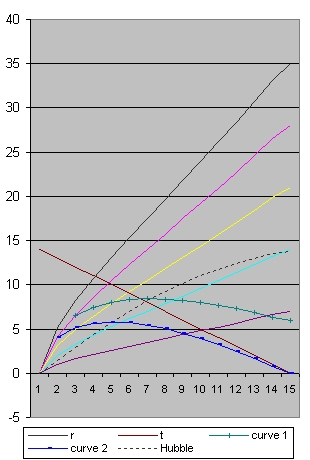The main stream opinion is that the Universe started with a Big Bang. This happend 13.7 billion years ago. At that same moment the Universe started to grow (expand) with a speed of slightly more than 3*c. There after the speed slightly slowed down and is now increasing again. This without considering inflation. To get an idea about this process please visit: friedmann's equation. This document shows that the present size of the universe is roughly 45 billion light years and what is the most important that of the total universe we can only observe a small bit, all in the past.
What this document also clearly shows is that what we observe now are events in the past.

|
|
- The first issue is that we observe only a small fraction of the universe. This raises the issue to what extend based on our observations we can claim something for the whole universe.
- The second issue is that the average expansion speed of space is much larger than the speed of light. This is the physical reason of the horizon problem, which maybe is not a problem at all. The horizon problem has nothing to do with what we humans observe but all with the physical processes after the Big Bang, which in principle don't require any form of inflation (extra expansion).
Reflection 2. Information and the speed of light.
-
All references to Information in the document should be modified, because it is misleading.
Within the concept of the Big Bang different era's are considered and the whole issue is to what extend there exixts a clear boundary between each.
The Book the Big Bang by Joseph Silk considers the following: Plank time, Inflation, Hadronic, Leptonic, Radiation, Matter and Decoupling. All of these Era's are charectorized by different processes which should take place in the whole of the expanding Universe.
Generally speaking photons are of no importance in these processes (or minimal). The speed of light is most important to make observations.
One question to answer is: can an observer outside the Universe (as created by the Big Bang) observe the Big Bang.
The issue is, if from the outside all the matter that caused the Big Bang is not something like a hugh black hole from which no light can escape? If that is the case an observer from the outside cannot visible observe the Big Bang.
Reflection 3. Inflation theory versus Horizon problem.
-
The inflation theory was supposed to solve the Horizon problem. The Horizon problem is partly based on the observed uniformity in the Universe. This uniformity is considered a problem because how can different patches be similar when at present the distances between these patches is extremely large. The most probably reason is that all what exists has a common origin and evolved under more or less identical conditions.
A case in point to consider is the CMB radiation which was created during the Decoupling Era. At that time the Universe was very small. The question is: if at that period the Universe was already uniform? Specific the sphere at the out layer of the Universe? The next question is: if this uniformity was caused by inflation.
IMO I see no reason to suppose that.
Anyway, and that is the most important consideration, the current size of the Universe has nothing to do with this.
Feedback
If you want to give a comment you can use the following form Comment form
Created: 8 June 2017
Go Back to Wikipedia Comments in Wikipedia documents
Back to my home page Index